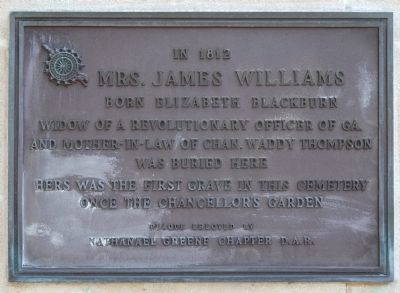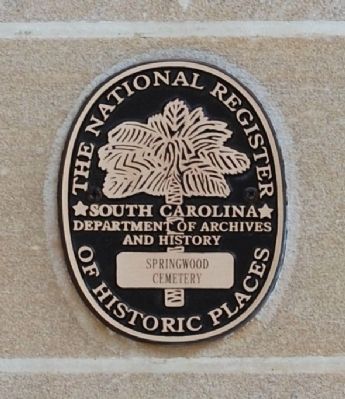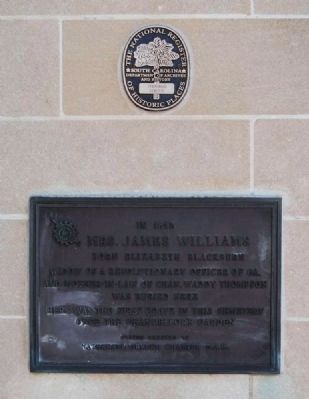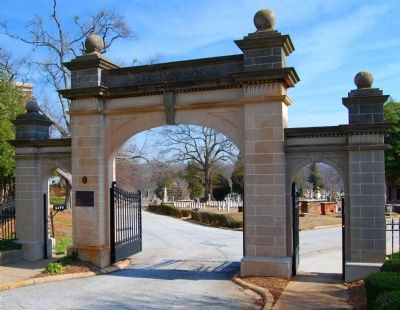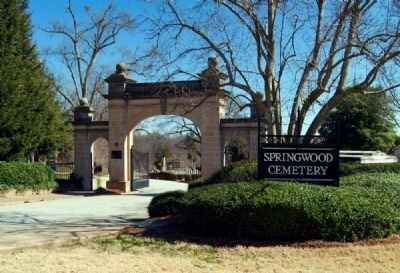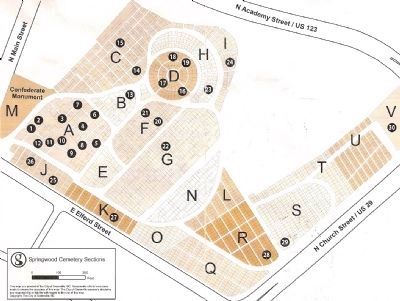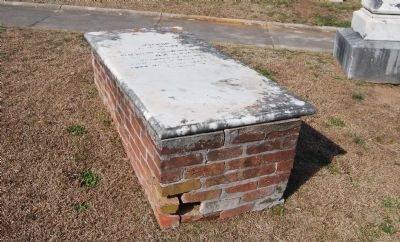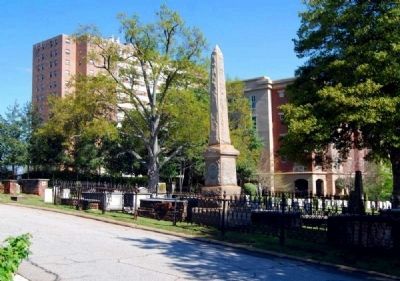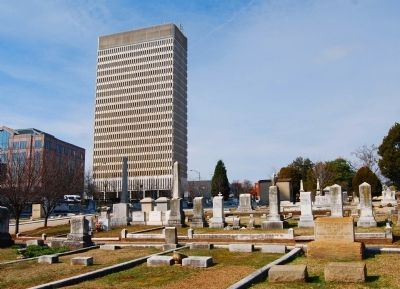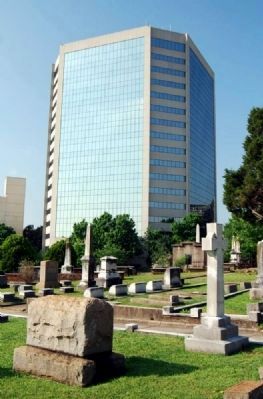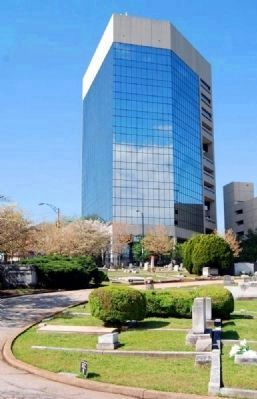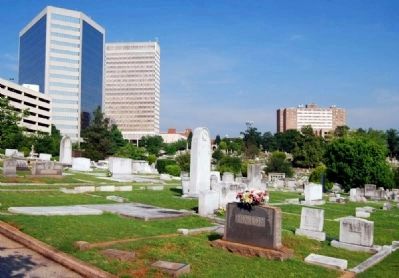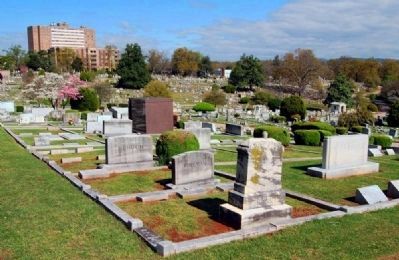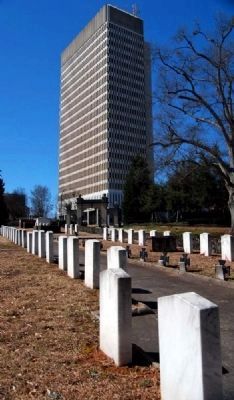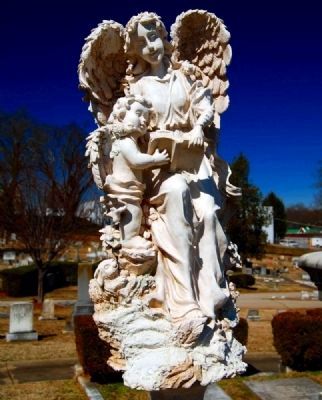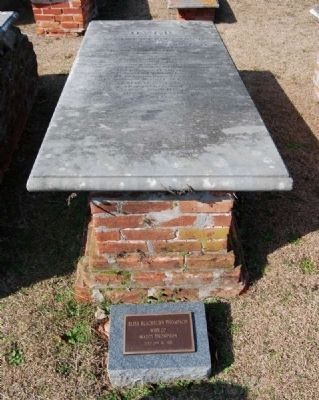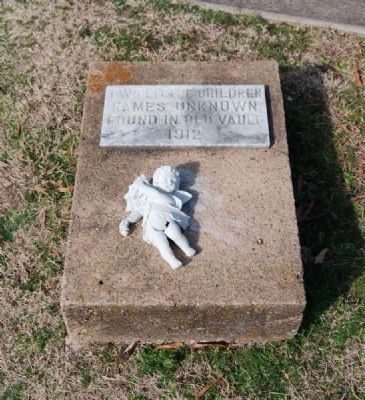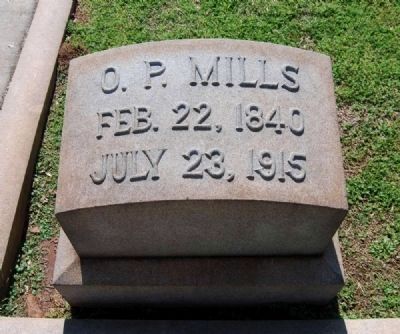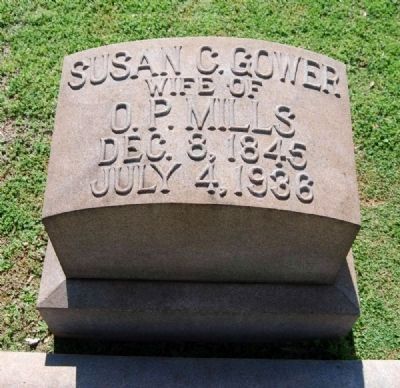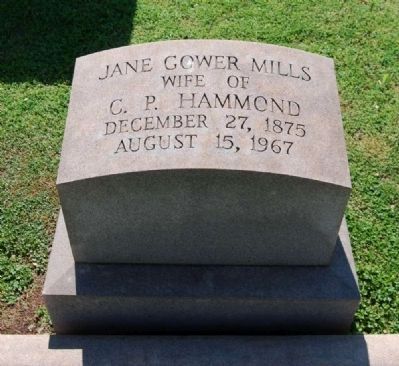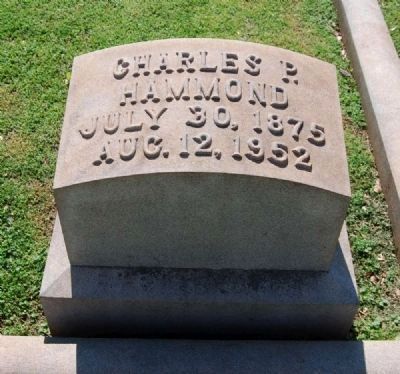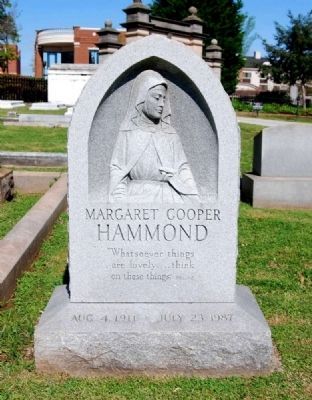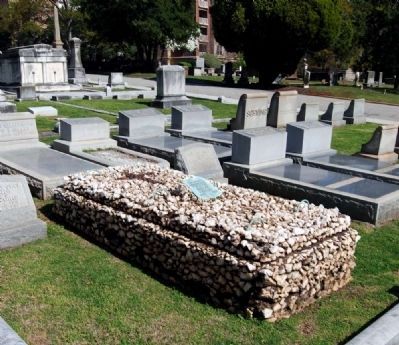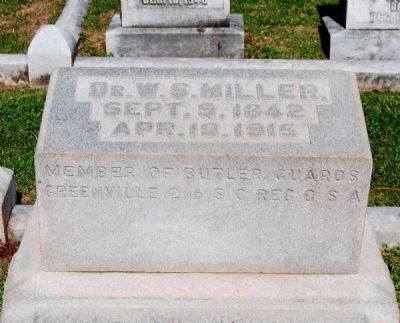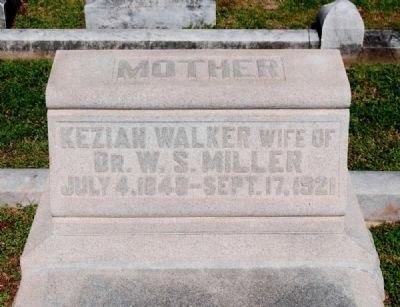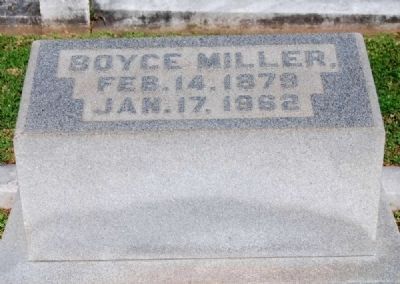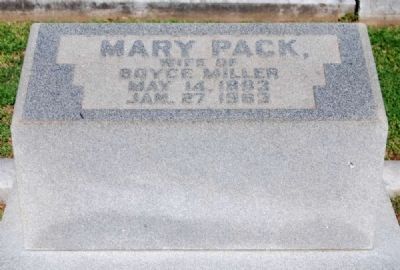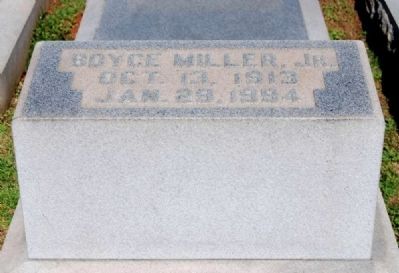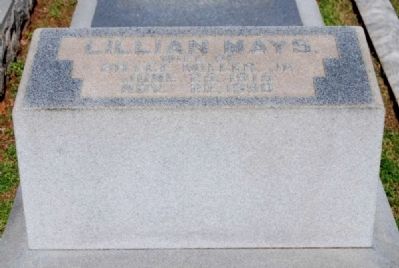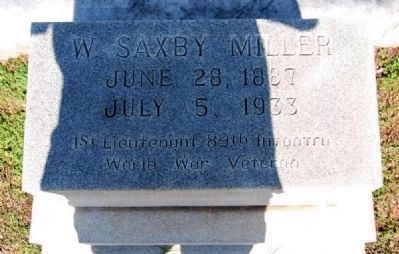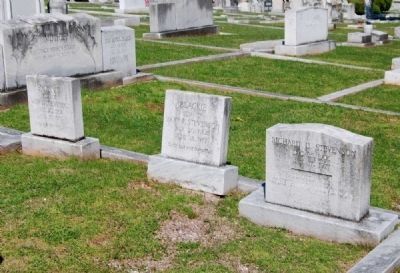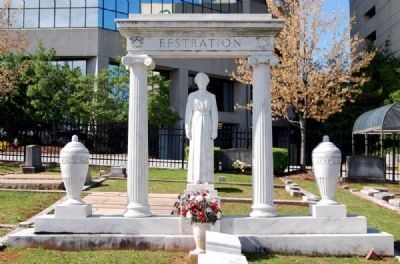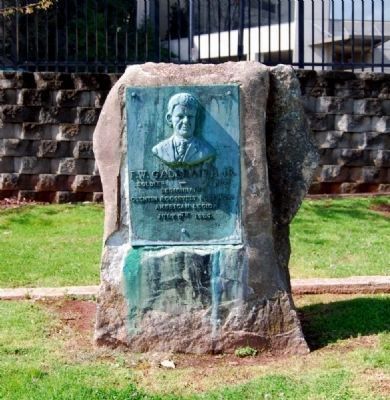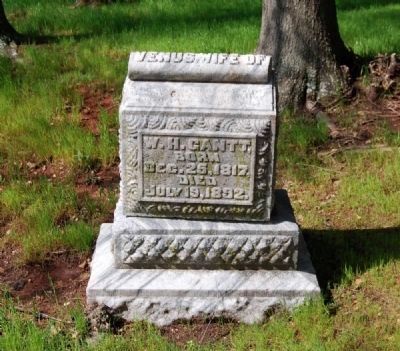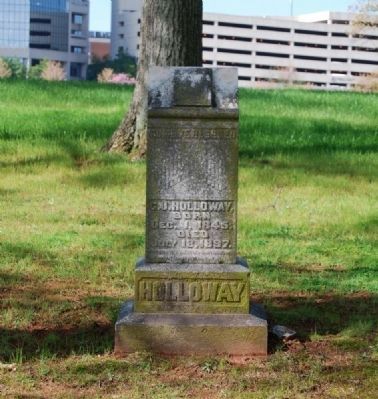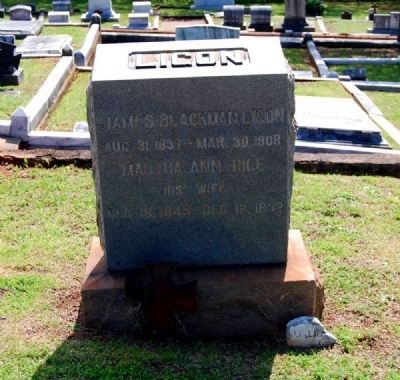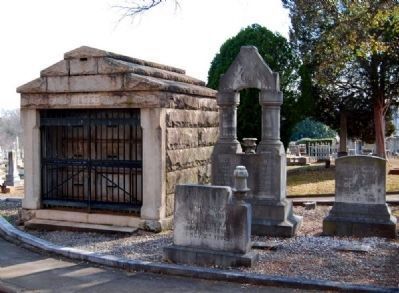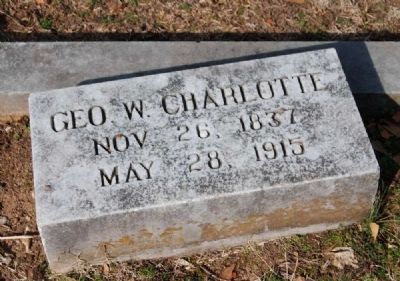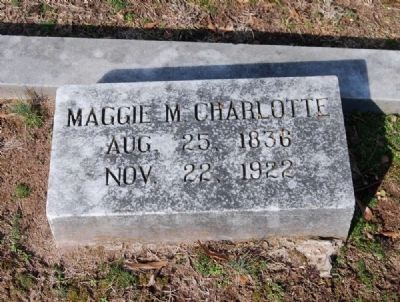Greenville in Greenville County, South Carolina — The American South (South Atlantic)
Mrs. James Williams
Mrs. James Williams
Born Elizabeth Blackburn
Widow of a Revolutionary Officer of Ga.
and Mother-in-Law of
Chan. Waddy Thompson
was Buried Here.
Her's was the First Grave in this Cemetery
Once the Chancellor's Garden.
Erected by Nathaniel Greene Chapter, Daughters of the American Revolution.
Topics and series. This historical marker is listed in these topic lists: Cemeteries & Burial Sites • Education • War, US Revolutionary • Women. In addition, it is included in the Daughters of the American Revolution series list. A significant historical year for this entry is 1812.
Location. 34° 51.283′ N, 82° 23.8′ W. Marker is in Greenville, South Carolina, in Greenville County. Marker is at the intersection of North Main Street and Elford Street on North Main Street. Plaque is located on the front entrance of the Springwood Cemetery main gate. Touch for map. Marker is at or near this postal address: 350 N Main St, Greenville SC 29601, United States of America. Touch for directions.
Other nearby markers. At least 8 other markers are within walking distance of this marker. Greenville County Confederate Monument (within shouting distance of this marker); Springwood Cemetery (within shouting distance of this marker); Eighty Unnamed Soldiers (within shouting distance of this marker); General Robert E. Lee (within shouting distance of this marker); Kershaw Brigade (within shouting distance of this marker); Confederate Armory (within shouting distance of this marker); SC Ordinance of Secession (within shouting distance of this marker); In Memory of 81st Wildcat Division / Camp Sevier (within shouting distance of this marker). Touch for a list and map of all markers in Greenville.
Also see . . . Springwood Cemetery. Springwood Cemetery is locally significant for its association with a number of persons important to the early history and development of Greenville, and for its funerary art and distinctive landscape design which reflect the rural cemetery movement of the mid to late nineteenth century. (Submitted on February 2, 2009, by Brian Scott of Anderson, South Carolina.)
Additional commentary.
1. Springwood Cemetery: A Historic Tour
A Short History
1784 - The original site of cemetery was land granted to John Timmons.
1807 - Land purchased by Chancellor Waddy Thompson.
1812 - First person buried was Waddy Thompson's mother-in-law Elizabeth Blackburn Williams.
1817 - Thompson sold land to Francis H. McLeod (charter member of Presbyterian Church of Greenville Courthouse).
1829 - Old Village Graveyard of Village buying Ground land sold for $1 to City Commission of Streets and Markets for "sole and exclusive use of a cemetery or graveyard, to be appropriated entirely as a repository for white persons."
1872 - Size of cemetery increased when Elford Cemetery was added as a result of the settlement of C.J. Elford's estate.
1876 - "Springwood Cemetery" was designed by architect, Godfrey L. Norman.
1881 - Cemetery gates and fencing installed.
1898 - The price of grave sites was six for $56.00.
• There are an estimated 2,200 family plots in Springwood Cemetery.
• It is unknown how many people are actually buried on site.
• All grave sites are sold; however, sites are resold for $2,500 or more.
• A foreign place of birth is noted on at least sixty-seven tombstones with eleven countries being represented.
The Tour
Section A:
1) Unknown Soldier's Graves: A bronze tablet marks the burial section of 80 Confederate soldiers. Each individual grave bears a white granite marker. More than 120 other
Confederate soldiers are buried in marked graves throughout Springwood.
2) Charlotte (11/26/1837-5/28/1915): George W. Charlotte fought in Stuart's brigade with General Lee. After the war he became a newspaper editor in North Carolina. Later in his career, he served as editor for newspapers in Bishopville and Rock Hill, Sc. He died 6 months away from his golden wedding anniversary. His son John M. Charlotte started the Daily Herald that later became the Greenville Piedmont and was also the managing editor of the Greenville News.
3) Elford (5/11/1820-5/25/1867): Col. Charles J. Elford raised the 16th regiment in the Civil War. He was the owner of the land that was part of the original Springwood Cemetery. His house on North Main Street became the first Poinsett Club.
4) Plot for Southern Baptist Seminary: The Southern Baptist Seminary was located in Greenville from 1859 -1877. The Seminary purchased a plot in Springfield where faculty members could be buried. William Williams was on the faculty, which included Toy, Whitsett, Boyce, Broadus, Manly and Pettigru.
5) Cauble (11/15/1789-1/17/1877): Peter C. Cauble, Sr. was a blacksmith on the corner of Main and West Coffee Street. The alley through his property from South Main and Fall Street was called Pig Tail Alley. Mr. Cauble was a slave owner who was also a Legal Guardian of several free blacks.
He served as Commissioner of the Poor.
6) Plot for Furman University: Furman purchased 84 plots in 1863. Notables buried in the plot are Charles Judson, (first professor hired by Furman University when the school moved to Greenville and the 12th President of the Greenville Female College) and Mary Camilla Judson (the principal of the female college); Furman University Presidents Edwin Poteat and Dr. W.J. McGlothlin.
7) Furman: James Clement Furman, first President of Furman University, and James C. Furman II and their wives are buried adjacent to the Furman University plot.
8) Williams/Thompson: Mrs. Elizabeth Blackburn Williams, widow of a Revolutionary War officer, was the first person to be buried in Springwood Cemetery. Mrs. Williams was the mother-in-law of Chancellor Waddy Thompson, one of Greenville's early civic leaders. She was buried in 1812 in one of the Chancellor's gardens which is now part of the cemetery. Chancellor Thompson and his wife are buried near Mrs. Williams.
9) Murphy (1/15/1801-6/30/1877): Samuel Moseley Murphy was a cabinetmaker, piano tuner and tombstone engraver. Mr. Murphy's tombstones were known throughout the country because of the placement of his "brand" on each tombstone he engraved. When Mr. Murphy died his estate was worth only $10.25, thus providing funds only sufficient for a marker that was modest in comparison to those he engraved.
10) Dunham (3/6/1786-3/15/1853): Benajah Dunham was the President of Greenville Manufacturing Company as well as a tinsmith, a mechanic and a farmer. He was also the Commander of a Militia Calvary Regiment and one of the founders of the Southern Patriot, a (pre-Civil War) unionist newspaper. Mr. Dunham was the first Intendent (or Mayor) of Greenville.
11) Chick (1/15/1776-1/25/1847): Dr. Burwell Chick of Charleston bought land at Lick Springs in 1840 where he founded Chick Springs Mineral Springs Resort. By the 1850s, 100 people a day were visiting his resort that had become Chick Spring Hotel.
12) Unknown Childrens Grave: In 1912, two children of a local sharecropper were buried on this site after being moved from the vault of a mausoleum that was needed by the owner.
Section B
13) Turner (6/27/1833-9/15/1903): J.C.C. Turner served in the Civil War. He manufactured black walnut and metallic coffins and caskets. He partnered with James F. Mackey in Turner and Mackey Furniture Store.
Section C
14) Mackey Family: JamesF.Mackey (7/16/1849-8/16/1916) - James F. Mackey was a pioneer of mortuary science in Greenville and founded Mackey Mortuary in 1882. (wife: Sarah Bullard Mackey 2/27/1822-1/26/1897) James J. Mackey (1/26/1817-4/27/1901) - James J. Mackey was a gunsmith and firefighter who was in Columbia to receive the hose-carriage sent by NYC firefighters after the burning of Columbia during the Civil War (wife: Nellie Hipp Mackey 4/25/1862-7/2/1943). Other Mackey family members are buried in Section Q.
15) Garraux (11/28/1828-3/25/1909): Elizabeth Garraux, born in Berne, Switzerland, came to Greenville in 1872 from Asheville, North Carolina. Mrs. Garraux was a gardener and a winemaker. In 1883 she grew 5,000 lbs. of grapes and made 700 gallons of red wine.
Section D
16) Fred W. Symmes (6/9/1879-5/23/1957): Fredrick W. Symmes, community leader and philanthropist, was the President of Nuckasee Manufacturing Company, Piedmont Plush Mill, Greenville chamber of Commerce as well as Director of the First National Bank, S.C. and Community Chest.
17) Parker (8/18/1876-5/16/1898): Wade Hampton Parker was the first soldier from Greenville to die in the Spanish-American War. Soldiers from the Butler Guards under Capt. F.B. McBee led the funeral procession which included a military salute for Parker.
18) Heldman (3/25/1819-10/3/1892): George Heldman was a saddlemaker who came to Greenville from Germany in 1846. He became one of the wealthiest men and largest land owners in the county. Since Heldman's house was located next to the jail, he was able to charge folks a fee to watch hangings from his outbuildings.
In 1889, his daughter Fannie drowned herself in the Reedy River rather than marry her father's business partner. Many years after the death of the Heldmans, a lady presented the deed to the Heldman's plot to the City. Even though her father had won the deed in a poker game, the City would not exhume the remains because the area was already "occupied".
19) Ansel (12/12/1850-8/23/1945): Martin Frederick Ansel was an attorney and County Judge. He was also the first native Greenvillian to be elected as Governor of South Carolina. He was elected in 1906 and served two terms.
Section F
20) Gilreath (7/9/1836-1/28/1912): P.D. Gilreath served in the Civil War with Col. Elford's 16th. He was a farmer until he was elected sheriff at age 40. He never carried a gun; his courage and integrity were so widely respected that he never needed one.
21) Shumate (11/28/1827-6/25/1916): W.T. Shumate served as a Captain in the Civil War. Mr. Shumate was a partner in Shumate, Grady & Nichols, builder/contractors. He was a depot agent for the Air Line Railroad and served as sheriff.
Section G
22) Carpenter Family Plot: A.B., T.S., J.L., and W.B. Carpenter established Carpenter Brothers Drug Store in 1889. The Carpenter bothers owned a total of five drug stores with the most well-known located on Main Street across from the Poinsett Hotel. This drug store were the first store in the area to sell Coca-Cola.
23) Ligon (8/31/1837-3/30/1908): James Blackburn Ligon served as the "model" for the Confederate Soldier Monument just outside Springwood Cemetery. Mr. Ligon was the first volunteer with Company G ofthe 4th South Carolina Volunteers and the Police Chief in Greenville.
24) Infant Burial Site: This is the burial site for infants of transients and paupers.
25) Miller Family: Tweetie Miller Carter (1875-1931) - Second wife of R.B. Carter and daughter of prominent physician W.S.D. Miller of Butler township. When she died, funeral services were held on the lawn of the Miller plantation and she was buried in the Miller family plot in Springwood.
26) Mills (2/22/1840-7/23/1915): Otis Prentiss Mills was one of the first captains of industry in Greenville. Born in North Carolina, he served in the Confederate Army and married Thomas Gower's daughter, Susan. Mr. Mills ran a successful dairy, Millsdale Stock Farm. He was of the opinion that large cows gave the finest milk and the most butter. He organized Mills Mill or Mills Manufacturing and became its President and Treasurer.
27) World War I Veterans' Burial Site: The first soldier to be buried in the plot was Fred Kirk (11/7/1917). Also buried in the plot are twenty soldiers from Camp Sevier that died during the Spanish influenza epidemic in 1918. The Greenville News reported the "caskets were stacked like cordwood at the depot" as a result of the outbreak.
28) Stevenson Family: Mary Payne and Richard Stevenson's dogs Brownie and Blackie were embalmed and buried separately in infant vaults in the Stevenson's plot. Both have markers "Son of Mrs. Mary P. Stevenson ... gone but not forgotten".
29) Phillips Family: Mrs. Phillips requested that her cat be buried on top of her since the cat always slept on her stomach.
30) African-American Burial Site: Some known and many unknown Mrican Americans are buried in this area.
Gantt: Captain W.H. Gantt, freed slave, barber and owner of property in Greenville, Pickens and Piedmont.
Snead (11/15/1847-3/6/1889): Virginia Snead was probably a freed slave of Chancellor Waddy Thompson.
Talley (1799-1/16/1872): Dudley Talley, an ex-slave and drayman, brought his freedom and land between Court and Broad Streets from George F. Townes. (Source: Springwood Cemetery: A Historic Tour, brochure by the Historic Greenville Foundation and City of Greenville Parks and Recreation available just inside the cemetery entrance.)
— Submitted February 2, 2009, by Brian Scott of Anderson, South Carolina.
2. Springwood Cemetery
Springwood Cemetery occupies approximately thirty acres in downtown Greenville. The cemetery is bounded on four sides by public streets: Main Street to the west; Elford Street to the south; Church Street to the east; and Academy Street to the north. The Kilgore-Lewis House, a restored nineteenth century home and surrounding gardens, also borders Springwood to the north, along Academy Street. Greenville’s central business district begins just one block south of Springwood. A small Confederate Monument park, relocated to its present location in 1923, lies just outside the Springwood boundary along Main Street. Immediately north of the cemetery is McPherson Park (formerly Greenville City Park). Historic Richland Cemetery, the city-owned African American burial ground, is located diagonally across Church Street.
The cemetery’s main gate is positioned at the corner of Main and Elford streets. It features a large central arch under which the main driveway passes, as well as two smaller arched entries on either side for pedestrian access. The name “Springwood” is engraved atop the central entablature. A plaque on the gate erected by the Nathanael Greene Chapter of the Daughters of the American Revolution identifies Mrs. James Williams’s 1812 grave as the first in the cemetery. A portion of historic iron fencing runs in either direction from the main gate. The remainder of the cemetery’s perimeter is defined by a (non-historic) black metal fence. A second entrance is located at the midpoint of the eastern portion of the cemetery off of Church Street. A small records building is the only structure located on the premises.
Springwood features a formal, planned design. A series of winding paved roads run throughout the cemetery and dissect it into several sections labeled chronologically from A to T. The oldest section, A, is located nearest the main entrance. Concrete sidewalks (most likely installed during the 1914 beautification) traverse the individual sections further defining the landscape. In the oldest sections, walkways are arranged irregularly around some of the earliest gravesites. Sections dating from the mid to late nineteenth century feature circular and semi-circular walks designed by Gottfried L. Norrman, a landscape architect inspired by the rural cemetery movement. The most recently developed sections feature rectilinear sidewalks, evenly-spaced plots and modern markers more typical of lawn cemetery designs.
Family plots are identifiable by a variety of design elements including trees, plantings and other natural features; stone, brick and marble edging; wrought and cast iron fencing; and contemporary fencing materials. Many of the plots feature the family name engraved in the stone borders. According to a survey completed in 1978, the plots contain approximately 7,700 marked graves. It is estimated that another 2,600 unmarked burials are located in the cemetery. The northeast corner, for example, which was historically used as a potter’s field for African-Americans and indigent whites, appears largely unused. Only a dozen or more headstones are visible, though it is suspected the area is fully occupied by graves.
Gravemarker types and materials vary dramatically from natural fieldstones to raised brick tombs to elaborate Victorian monuments to Greek peristyles and sculptures to contemporary marble headstones. The variety and style of monuments reflects the long history of Springwood Cemetery as well as the socio-economic diversity of those buried there. Manufactured funerary art includes monoliths, engraved tablets, ledgers, table markers and ornamental headstones. Symbolic images are evident throughout the cemetery: angels; lambs, doves and other birds; tree stumps and broken columns; clasped and praying hands; open books; wreaths, ivy and other flowers; urns; and architectural motifs such as gates and arches. Biblical and personal inscriptions are common as well.
Springwood Cemetery features small knolls and gradual slopes which afford a number of dramatic views of the architectural and natural scenery. The landscape includes a variety of tree and plant
species typically found in historic cemeteries throughout South Carolina. Among the most prominent trees are several mature magnolias, oaks, cedars and dogwoods. Azaleas, holly, boxwood and privet hedge are prevalent throughout the cemetery. Modest landscaping and ground cover has been introduced at the two entrances. Contemporary signs reading “Historic Springwood Cemetery” are located in the planters at each entrance. At one time, the cemetery property purportedly included a spring, nicknamed “Thank God for Water Spring,” and for which the cemetery is named. Located toward the north end of the cemetery, the spring fed a small pond. Both features are identified on the 1912 map of Springwood, but they are not included on later plats. It is unclear whether these water features were included within the cemetery’s boundaries or rather just outside them in the City Park (now the grounds of the historic Kilgore Lewis House).
Springwood Cemetery continues to operate as a municipal burial ground, although all available plots have long since been sold.
Integrity
Springwood has experienced growth and alteration throughout its nearly 200 years of existence,
reflecting local tastes and development. A nineteenth century masonry sexton’s house once stood near Main Street but was razed ca. 1970. In April 1969, the creation of Academy Street seized cemetery land once used for the burial of African Americans. Those graves were relocated to Pinedale Memorial Park in Greenville County.
Despite its evolution, Springwood Cemetery retains its historic integrity. Springwood is situated in its original location and still features its historic rural cemetery design elements and park-like setting. Because of the variety of stone used, the material condition of funerary art within the cemetery varies dramatically. The mortar on early nineteenth century brick graves has deteriorated in places.
Inscriptions on many of the oldest tablets and table stones have faded. Some monuments, particular ornate monoliths, have toppled or separated from their base. The overwhelming majority of original materials, however, are extant and in fair condition. The original workmanship of stone carvers is evidenced by the variety of historic gravemarkers. The 1876 landscape design of Gottfried L. Norrman is unchanged. With the exception of acquiring additional acreage, the site has not been significantly altered since its creation. Visually and physically, the cemetery retains the same historic feeling as it did during its periods of historic significance. Springwood Cemetery maintains a strong, traditional association with many of Greenville’s most influential families and individuals.
Significance
Springwood Cemetery is eligible for listing in the National Register of Historic Places under Criteria A, B, and C and Criteria Consideration D. Springwood is locally significant for its association with a number of persons important to the early history and development of Greenville, and for its funerary art and distinctive landscape design which reflect the rural cemetery movement of the mid to late nineteenth century.
Criteria A and B: Community Planning and Development
The first burial in what would become Springwood Cemetery occurred in 1812, when Elizabeth Blackburn Williams was buried in the garden of her son-in-law and daughter, Waddy and Eliza Thompson. Thompson, a prominent attorney from Washington, Georgia, acquired this land in 1807 and constructed a house near the intersection of Elford and Church streets. Thompson resided there with his wife, Eliza, and her mother, Elizabeth Blackburn Williams. On July 15, 1812, Elizabeth Williams was buried behind the house in the Thompson’s garden, in accordance with her wishes. Ms. Williams’ raised brick grave was the first burial in what would become Springwood Cemetery.
Waddy Thompson sold three acres of his land to David Henning in 1814. Three years later, he sold some 60 acres to Francis McLeod. In 1829, McLeod opened an acre of his land to public burial. In 1833, McLeod conveyed an additional tract of land to the Commission of Streets and Markets for the “sole and exclusive use of a cemetery or graveyard, to be appropriated entirely as a repository for white persons.” The cemetery continued to grow through the acquisition of adjacent acreage in 1871, 1872, 1875 and 1876. In 1941 the Springwood Cemetery acquired land on the former site of the Allen School (along Church Street), which burned that year.
Springwood is presumably named for the wooded area surrounding a natural spring that once was on the grounds. Over the years, Springwood has been known by various names including Elford Cemetery, the Old Graveyard and the Old Village Burial Ground.
Criterion B
Springwood Cemetery is the final resting place of many of Greenville’s most prominent citizens.
Many of the upcountry’s most successful businessmen during the nineteenth century are buried in Springwood. In 1840 Dr. Burwell Chick (1776-1847), a native of Charleston, established the widely popular Chick Springs Mineral Springs Resort (later Chick Springs Hotel) at Lick Springs. Samuel Moseley Murphy (1801-1877) was a very successful cabinet maker and tombstone engraver, credited with the design of several elaborate headstones in Springwood Cemetery. Ironically, at the time of his death his diminished estate provided only for a modest personal marker. George Heldmann (1819-1892) was one of the wealthiest men and largest landowners in Greenville County. An immigrant from Germany, Heldmann was an accomplished saddle maker. The Garraux family plot contains the graves of Elizabeth Garraux (1828-1909), a wine grower from Switzerland, as well as John Garraux, sexton of Springwood Cemetery from 1910-1928, and his son, Tom, sexton of the cemetery from 1928-1970. J.C.C. Turner (1833-1903) was a Confederate veteran who managed a Turner and Mackey Furniture Store with partner James F. Mackey. He was also a manufacturer of coffins and caskets. The Mackey family plot contains the graves of James J. Mackey (1817-1901) and James F. Mackey (1849-1916). James J. was a gunsmith and firefighter, while James F. was the business partner of J.C.C. Turner. The younger Mackey was also an expert in the field of mortuary science and established the Mackey Mortuary, still in operation, in 1882. George W. Charlotte (1837-1915) became a newspaper editor in North Carolina following service in the Confederate army. He later served as editor for papers in Bishopville and Rock Hill. His son, John, founded the Daily Herald (later the Greenville Piedmont), and subsequently managed the Greenville News. Otis Prentiss Mills (1840-1915) operated a successful dairy operation at his Millsdale Stock Farm. He later founded Mills Mill, a manufacturing plant where he served as president and treasurer.
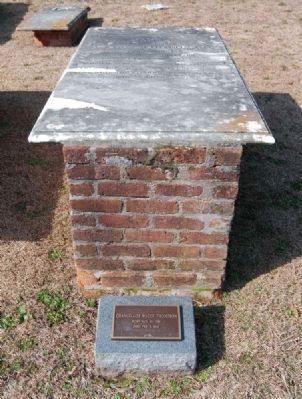
Photographed By Brian Scott, February 2, 2009
18. Waddy Thompson (1769-1845) Tombstone
to the Memory of
Waddy Thompson
who was born in Cumberland County, Virginia
on the 18th November 1769
and died in this place on the 8th February 1845.
He held the office of chancellor of the state
for twenty three years with signal ability and
was an able and virtuous magistrate and
an upright and honorable man.
In addition to teachers, professors and other administrators from around the upcountry, Springwood Cemetery contains the graves of several former Furman University leaders. The school acquired 84 plots in 1863. Among those buried in the Furman plots are Charles Judson, the first professor at Furman’s Greenville location and a president of the Greenville Female College; Mary Camilla Judson, principal of the Female College; and Edwin Poteat and Dr. W.J. McGlothlin, former presidents of the university. Also buried in Springwood in a family plot is James Clement Furman, the first president of Furman and the son of Richard Furman, namesake of the school, and several Furman family members.
Springwood is also the burial place several individuals important to the early settlement and organization of Greenville and the upcountry. Among the important civic, legal and political leaders buried in the cemetery
are Waddy Thompson (1769-1845), a prominent attorney and Chancellor of the South Carolina Court of Equity also known as the “Father of Springwood.” Thompson built his home on present-day Springwood and his mother-in-law’s 1812 grave was the first on the site. Benajah Dunham, a successful businessman and founder of the unionist paper, Southern Patriot, was the first intendent (mayor) of Greenville. Peter C. Cauble, Sr. (1789-1877) served as Commissioner of the Poor and ran a blacksmith shop at the corner of Main and West Coffee streets. Colonel Charles J. Elford (1820-1867) was a prominent landowner in early Greenville. His estate included part of the Springwood site (Elford’s Cemetery), and his house on North Main Street became the first Poinsett Club. Elford also raised the 16th South Carolina Infantry for Confederate service in the Civil War. Another Confederate veteran, W.T. Shumate (1827-1916) served as sheriff and was a partner in the construction firm of Shumate, Grady & Nichols. P.D. Gilreath (1836-1912), also a Civil War veteran and local sheriff, was reportedly so well respected that he never carried a gun. Martin Frederick Ansel (1850-1945), an attorney and county judge, became Governor of South Carolina—Greenville’s first native son to do so—in 1906. One of Greenville’s most prominent businessmen, Charles Daniel (1895-1964) was said to
have one of the world’s largest construction companies. His influence in the Greenville business and political community was no less impressive. He served briefly as an interim U.S. Senator.
Springwood contains the graves of veterans from every significant American military conflict. Patriots of the American Revolution rest in Springwood, as does Robert A. Joyce, killed in 1847 in the Mexican War. In addition to the many graves of prominent officers who served in the Civil War, a commemorative plaque identifies a section of the cemetery near the main gate where eighty unmarked Confederate graves are located. Though Greenville servicemen did not see action in the Spanish-American War, they organized and served in Florida in support of the war effort. At least one of those men, Wade Hampton Parker, is buried in Springwood. The cemetery also contains a section for World War I veterans, the first of whom to be buried was Fred Kirk in November 1917.
Twenty soldiers who died from the Spanish influenza epidemic at Camp Sevier in 1918 are buried in this section. Several veterans of World War II are buried throughout the cemetery. In December 1947, a tree was dedicated to the men who gave their lives in that war. Veterans of the Korean and Vietnam Wars are also buried in Springwood Cemetery.
Criterion C: Areas of Significance: Art; Landscape Architecture
Art: At nearly 200 years old, Springwood Cemetery boasts a comprehensive collection of gravemarker types, materials and styles. Primitive markers include field stones, small slabs of slate and modest tablets with little or no inscriptions. Some of the earliest graves are raised masonry tombs topped with inscribed stone ledgers which reflect eighteenth century burial design. The section of the cemetery traditionally occupied by black citizens reflects vernacular African American burial design. Many graves are unmarked, and those that are feature modest monuments of disparate detail. By mid century, Victorian society began to embrace a more sentimental outlook on death and mourning. Such views inspired elaborate memorials and funerary art that celebrated both life and the afterlife. Specifically, all variety of monoliths reflected popular transcendental and heavenly associations. Symbolic imagery like angels, lambs, doves, gates and flowers proliferated as well.
The design of funerary monumentation gained standing as a professional trade, and craftsman like Samuel Murphy took great pride in their work. Springwood contains numerous examples of elaborate Victorian cemetery art. Twentieth century cemetery design continued to feature elaborate monuments, particularly classical designs. Overall, grounds were organized more symmetrically than before. Regular sections, plots and markers
gave modern cemeteries a more sanitized look that allowed caretakers efficient maintenance of the grounds. The newest sections of Springwood reflect this new taste. Several veterans’ graves—whether from the Civil War or World War II—feature markers furnished by the Veterans’ Administration.
Landscape Architecture: Rural cemeteries became popular in the United States during the 1830s.
Influenced by the picturesque gardens of Europe, American landscape architects began to incorporate natural designs and romantic themes into planned cemeteries. The first of these, Mount Auburn Cemetery in Cambridge, Massachusetts, established the rural cemetery movement and had a profound impact on all aspects of landscape design. Though it began as a small family burial ground, Springwood Cemetery exhibits many of the design features that characterized the rural cemetery movement. Its park-like qualities are the result of a planned landscape design from shortly after the Civil War. The site itself, just north of the center of present-day Greenville, is typical of many rural cemeteries. The topography, too, accommodates a scenic landscape: gentle hills provide pleasing vistas and scattered concentrations of vegetation provide for a natural environment in which manufactured monuments coexist in harmony. Such a connection between life and death, man and nature, were central
concepts to the rural cemetery movement. Norrman’s design took full advantage of the monuments and earth by encircling them with meandering, curved roads and walkways. The picturesque design is immediately evident from nearly any vantage within the cemetery.
Springwood became a formal, planned landscape when in 1876 Gottfried L. Norrman, a Swedishborn architect practicing in Spartanburg, designed the streets and plots. The Daily Enterprise reported on September 5, 1876 that “Mr. G.L. Norman, architect, has just completed a survey and the laying off into squares and drives of Springwood Cemetery, and the work appears to have been well executed. We examined the plat yesterday in his office. The work was done under instruction of Council.”
Norrman also may have designed the entrance, though it was not completed until much later. The entrance was constructed of Indiana limestone by J.R. Lawrence as part of a significant beautification effort by the city in 1914. The Greenville Daily News credited Alderman Henderson, the chairman of the cemetery committee, and Mrs. C.M. Landrum, founder of the Springwood Cemetery Association, for bringing about the many improvements to the cemetery. In addition to the new entrance, a two-story dwelling built of brick veneer with a granite foundation and fitted out with all modern conveniences was constructed to house the new cemetery sexton (the first being George Morris). Other beautification projects included paving and curbing all drives and walks. The city’s initiatives led The Greenville Daily News to predict in June 1914, “With improvements aggregating a cost of $12,000 already made in Springwood cemetery and plans underway to further beautify the place, Greenville will in a few years have one of the best kept and most attractive burying grounds in the State.”
Criteria Consideration D
Springwood Cemetery satisfies Criteria Consideration D for cemeteries because it contains the graves of a number of people of transcendent importance who helped determined the course of events in Greenville, particularly in the areas of commerce, education, industry, law, military and politics/government. Springwood Cemetery also contains a comprehensive register of cemetery materials and styles and exhibits distinctive design features that embody the principles of an aesthetic movement through its overall plan, landscaping, gravemarkers and funerary sculpture.
Conclusion
Springwood Cemetery is locally significant as a culturally, architecturally and historically significant site. The development of Springwood Cemetery was directly linked with the establishment and growth of Greenville. The cemetery is the final resting place of many of the most
prominent and influential families in Greenville’s early history. The funerary art that memorializes these persons of outstanding significance is equally noteworthy for its variety of materials and styles. Finally, Springwood Cemetery is significant as an extant example of a formal, planned rural cemetery design. (Source: National Register nomination form.)
— Submitted March 19, 2010, by Brian Scott of Anderson, South Carolina.
3. Downtown Cemeteries go National
by Melissa Blanton
The Greenville Journal
Chuck Gilreath tilts his head as he silently counts the number of relatives buried at Springwood Cemetery in downtown Greenville. He stops when he gets to 30. There may be more.
Mac Carpenter gazes at the white Georgia marble headstones that mark his family members’ graves. He knows of at least seven, including his father, once a prominent Greenville doctor.
“Unfortunately, there’s no room for me,” he said.
Carpenter serves as president of Friends of Springwood Cemetery, a citizens group aimed at preserving the downtown site. Gilreath is the organization’s treasurer.
Both want the cemetery to be around for their grandkids. And they believe a spot on the National Register of Historic Places will help one of Greenville’s first cemeteries remain an area landmark.
In July, the state historic review board unanimously approved both Springwood and Richland cemeteries for inclusion on the National Register of Historic Places.
For the past year, city officials have been working on a proposal that would include the two cemeteries on the register.
City Council took a trip to Boston in 2000 and visited a well-preserved cemetery in the Boston area.
“We were inspired,” said council member Chandra Dillard.
Soon after the trip, City Council passed a resolution creating the Friends of Richland and Springwood Cemetery.
Their purpose was to preserve Greenville’s history, said Dillard, who helped head up the Richland Cemetery group. Council member Michelle Shain took on the Springwood Cemetery project.
“We are kind of like the moms of the cemetery,” said Dillard.
In 2004, the city hired Palmetto Preservation Works to help complete the two separate national register applications. Before a property is considered for inclusion on the National Register of Historic Places, it must meet specific requirements.
Four broad requirements include significant people, events, unique construction and historic relevance.
Greenville is home to 41 sites listed on the National Register of Historic Places.
But
convincing state officials to approve a cemetery can be a difficult task.
“The cemeteries themselves have to meet a specific criteria,” said David Arning, principal with Palmetto Preservation Works.
The proposal had to include evidence that the cemeteries were of significant importance to the community. Arning said because of the people buried at the sites, that criterion was fairly easy to prove.
Two additional requirements for cemeteries are a unique design and notable funeral art.
Springwood dates back to 1784. Richland was established in the late 1800s as a burial site for blacks.
While the city owns the land occupied by both cemeteries, upkeep of the plots is left to surviving family members. And that’s where preservation groups from both sides face their biggest challenge- finding family members. Many have moved, are deceased or simply don’t know they have a family buried at the sites.
As a result, many sites have fallen into disrepair. Over time markers have sunk into the ground, brick monuments have crumbled and decades of rain and wind have left lettering unintelligible.
To compound the problem, in 2000 vandals knocked over about 30 markers, said Gilreath.
The task of cleaning and repairing the hundreds of decrepit plots is both costly and time consuming. And that’s where the National Register
listing may help.
The listing may make corporations more willing to donate. The sites would also be eligible for federal historic preservation funds, said Dillard.
The next step in the process is a review by the National Park Service, the organization that overseas the register.
— Submitted March 20, 2010, by Brian Scott of Anderson, South Carolina.
4. Local Cemeteries' Historic Significance Set in Stone
by Lorando D. Lockhart
The Greenville News
November 17, 2005
The first cemetery for blacks in Greenville County and a cemetery that's the final resting place for a number of Greenville pioneers are now officially pieces of local history.
Last month, Richland and Springwood cemeteries were placed on the National Register of Historic Places.
On Wednesday, families of those buried in the two cemeteries and those who have worked to protect them joined city officials in a brief ceremony at Greenville City Hall marking the National Register achievement.
Winifred A. Lykes, president of the Friends of Richland Cemetery, said he's proud of the cemetery's historic status.
"We have so many prominent citizens buried there," Lykes said. "Restoring and making historical reference to that area is very important
to me. For so many years, we have been forgotten, and this is a part of the city of Greenville."
Edna Lowe said she has a family member buried at Richland and tries to attend all meetings held by the board.
"I think it's a great thing because moving from Philadelphia to Greenville, we used to go over to Richland all the time," Lowe said. "I didn't know so many people were buried there that I had met at one time. A lot of my friends have family members who are over there."
Brad Sauls, a spokesman for the state Department of Archives and History, said having the two cemeteries placed on the register encourages future generations to want to learn more about Greenville history.
"The extraordinary and ordinary people who rest in these cemeteries were once part of the life of this city and helped create what it is today," Sauls said.
Sauls also presented plaques to members of both cemetery boards to signify their inclusion in a group of more than 1,300 historic places in South Carolina.
Richland Cemetery, which is located at Fern Street and Oakwood Avenue, was established in January 1884 as the first local municipal cemetery for blacks in Greenville County.
The cemetery features a variety of art and cultural artifacts, which provide information about ethnic burial customs in the South.
The cemetery has four
sections and includes the graves of William Sewell, builder of Sterling High School and S.C. Franks Mortuary, and Hattie Logan Duckett, founder of the Phillis Wheatley Center.
The cemetery is the resting place for more than 1,400 documented grave sites and sits on about six acres.
Springwood Cemetery, which is located at 410 N. Main Street, was first used as a burial ground in 1812. The site was opened for public burial in 1829 and became a planned landscape in 1876.
The cemetery is significant as the burial place for many early Greenville pioneers and contains more than 10,000 graves. Elizabeth Blackburn Williams, who died in 1812, was the first person buried in Springwood Cemetery.
Barbara Bayne, who represents Friends of Springwood Cemetery, was especially proud of the historical designations for both cemeteries.
"I just think it's a wonderful thing for Greenville and for the people it represents," Bayne said. "I feel like it's the coming together of two souls, hearts and minds of Greenville."
— Submitted March 20, 2010, by Brian Scott of Anderson, South Carolina.
5. Politicians Buried in Springwood Cemetery
Clement Furman Haynsworth, Jr. (1912-1989) — also known as Clement F. Haynsworth, Jr. — Born in 1912. Judge
of U.S. Court of Appeals for the 4th Circuit, 1957-81. Died in 1989.
Martin Frederick Ansel (1850-1945) — of Greenville, Greenville County, S.C. Born in Charleston, Charleston County, S.C., December 12, 1850. Son of John Jacob Ansel and Frederika (Bauer) Ansel; married, February 21, 1878, to Ophelia A. Speight (1858-1894); married, August 23, 1898, to Addie R. Harris. Democrat. Lawyer; member of South Carolina state house of representatives, 1882-88; Governor of South Carolina, 1907-11; defeated, 1902. Died August 24, 1945.
Charles Ezra Daniel (1895-1964) — of South Carolina. Born in Elberton, Elbert County, Ga., November 11, 1895. Democrat. U.S. Senator from South Carolina, 1954. Died in Greenville, Greenville County, S.C., September 13, 1964.
Roger Craft Peace (1899-1968) — also known as Roger C. Peace — of Greenville, Greenville County, S.C. Born in Greenville, Greenville County, S.C., May 19, 1899. Democrat. U.S. Senator from South Carolina, 1941. Died in Greenville, Greenville County, S.C., August 20, 1968.
John Jackson McSwain (1875-1936) — also known as John J. McSwain — of Greenville, Greenville County, S.C. Born near Cross Hill, Laurens County, S.C., May 1, 1875. Democrat. Served in the U.S. Army during World War I; U.S. Representative from South Carolina 4th District, 1921-36; died in office 1936.
Member, Grange. Died in Columbia, Richland County, S.C., August 6, 1936.
George Norwood — of Greenville, Greenville County, S.C. Republican. Member of Republican National Committee from South Carolina, 1940; delegate to Republican National Convention from South Carolina, 1940, 1948.
— Submitted March 21, 2010, by Brian Scott of Anderson, South Carolina.
Credits. This page was last revised on October 14, 2020. It was originally submitted on February 2, 2009, by Brian Scott of Anderson, South Carolina. This page has been viewed 4,514 times since then and 111 times this year. Last updated on October 10, 2020, by Julia Cowart of Greenville, South Carolina. Photos: 1, 2. submitted on February 2, 2009, by Brian Scott of Anderson, South Carolina. 3. submitted on March 19, 2010, by Brian Scott of Anderson, South Carolina. 4. submitted on February 2, 2009, by Brian Scott of Anderson, South Carolina. 5, 6. submitted on March 19, 2010, by Brian Scott of Anderson, South Carolina. 7, 8. submitted on February 2, 2009, by Brian Scott of Anderson, South Carolina. 9. submitted on March 19, 2010, by Brian Scott of Anderson, South Carolina. 10. submitted on February 2, 2009, by Brian Scott of Anderson, South Carolina. 11, 12, 13, 14, 15, 16, 17, 18, 19, 20. submitted on March 19, 2010, by Brian Scott of Anderson, South Carolina. 21, 22, 23, 24, 25, 26, 27, 28, 29, 30, 31, 32, 33, 34, 35, 36, 37, 38, 39, 40, 41, 42. submitted on March 20, 2010, by Brian Scott of Anderson, South Carolina. • Devry Becker Jones was the editor who published this page.
